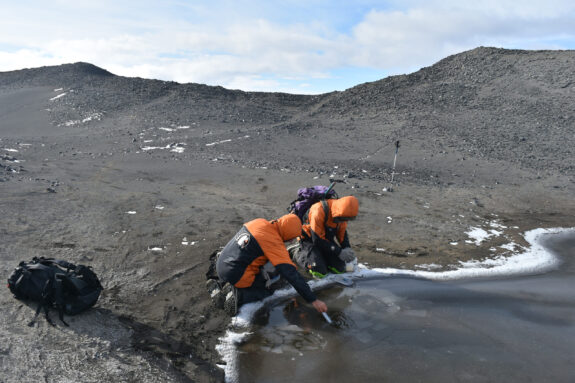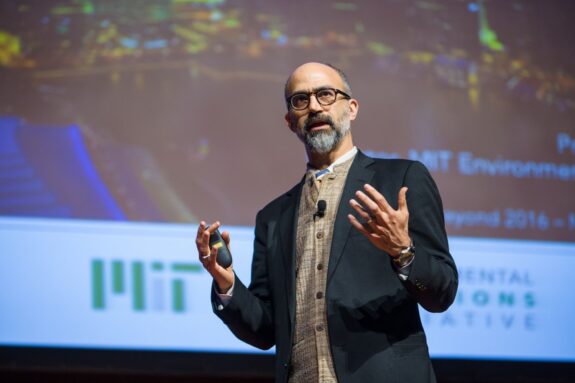Dixie Lee Bryant’s career was one marked by firsts: the first MIT student to earn an SB in Course XII; an inaugural member of the faculty at the North Carolina State Normal and Industrial College and the founder of North Carolina’s first chemistry laboratory open to women; one of the first five women enrolled at UNC Chapel Hill; the first woman to earn a PhD from the Friedrich-Alexander-Universität, Erlangen, Germany.
Now, more than 130 years after she set foot on MIT’s campus, a new first is being added to Bryant’s legacy. With the renovation and reopening of 54-100, made possible by a generous grant from Shell, the 400-seat auditorium in the Green Building—home to the Department of Earth, Atmospheric and Planetary Sciences (EAPS, Course XII)—Bryant will become the first MIT alumna to have a major venue named after her on campus.
Bryant’s long list of milestone achievements is particularly impressive when considered in historical context. Bryant grew up in a time when few women were able to become scientists. Born in Louisville, Kentucky in 1862, she was sent to the Columbia Female Institute, an Episcopal all-girls’ academy in Columbia, Tennessee, in 1868. At a time when neither Kentucky nor Tennessee yet had statewide public secondary school systems, a private education was often the only option for parents hoping to educate their daughters beyond basic grammar school. But, even then, female academies of the time were primarily finishing schools, with a focus on liberal arts, drawing, needlework, and music. In this regard, the Columbia Female Institute stood out from the rest. In an era when women were largely viewed by society to be intellectually inferior, the Reverend Franklin G. Smith of Vermont, an early vocal proponent for equal educational opportunities for women, was recruited as the school’s inaugural principal in 1937, and by 1841 he had established a curriculum at the Institute on par with that of peer male institutions, including algebra, geometry, calculus and the physical sciences—a development which likely had a profound influence over Bryant’s lifelong passion for science and learning.
Upon completion of her secondary school studies in 1878, Bryant taught in grammar schools in Tennessee, and later at Hamilton College, a girls’ academy in Kentucky—often the only viable career path for women of the time without college degrees. While some Southern universities had begun accepting women to liberal arts programs, Bryant hoped for a career in science and found no institutions in the region willing to enroll women in their scientific programs. So, in a theme that would recur throughout her career, she was forced to look elsewhere to pursue her passion. In 1887, after passing the science entrance exam for MIT, Bryant was admitted to study geology. She also became one of the very first recipients of a Joy Scholarship—a $600 scholarship established the year prior by Miss Nabby Joy, a Boston philanthropist, “for the benefit of one or more women studying natural science at MIT.” Bryant went on to earn the scholarship for a second year in 1888.
While two SB degrees in geological subjects had been awarded by the Institute before the formation of Course XII, these were earned as geologic options of Course VII and Course III more than a decade prior. In 1890, while Bryant was in her third year of study, MIT officially established the new Course XII, Geology. And, in 1891, with the presentation of her dissertation, “Determination of Certain Fossils Found in the Charles River Basin,” and successful oral examinations in geology, mineralogy, and zoology, Bryant became the very first student to earn a bachelor’s degree—with honors—from the department we know today as EAPS.
The President’s Report at the time describes the department’s earliest moments, and Bryant’s milestone achievement as its first graduate:
“The establishment of this Course was announced in my report last year. One student who had previously taken a sufficient amount of geological and correlated studies at the Institute to meet the requirements of the first three years, was at once admitted as a regular student of the fourth year, and at its close became the first graduate of the course as it now exists. (Dixie Lee Bryant). The results presented in the graduating thesis were of scientific merit; and some of them will soon appear in connection with other studies in the same direction, in two of our leading scientific journals. At present there are students, regular or special, enrolled in each year of the course; and instruction is now in progress in all the regular geological subjects which were introduced by the organization of the course.”
After graduation from MIT, the 29 year old Bryant spent a year teaching natural science at the New Hampshire State Normal School at Plymouth. “Normal” schools of the time were teachers’ colleges, where students (usually women) were educated in pedagogy and advanced subjects. But, perhaps surprisingly, at NH State Normal, Bryant was one of only two female faculty to hold a university degree, and the only one with a science degree.
The following year, Bryant was hired as a charter member of the faculty at the newly-opened North Carolina State Normal and Industrial College (which later became UNC Greensboro). When the college opened in 1892, it too, like the Columbia Institute, was groundbreaking in its early-roots feminist approach to educating women. In a history of the school, Learning to Be New Women, Pamela Dean writes that from the outset, “The college’s overt mission was to train teachers for public schools, women who would lead the battle for education and aggressively propagate the values and skills that southerners needed if they were to move from the rural, agricultural world of the Old South to the urban, entrepreneurial, industrial world of the New.” The school was headed by President Charles McIver, an empassioned education reformer and advocate for women’s independence, and led by a faculty of 15—only three of whom were men, including McIver. Of the twelve faculty women, only one was married, and nearly all possessed degrees from leading universities.
Bryant was the school’s first head of the science department, where, according to her own words, she, “put in a curriculum of the simplest four year college courses such as women’s colleges of the North had.” During her first year, she taught six courses: physical geography, systemic and structural botany of flowering plants, general chemistry, physics, zoology, and geology. In another statement on the status of women’s secondary-school education at that time, she often found herself tutoring students who arrived to the program lacking any foundation in the sciences.
As science department head, she set to work building the school’s scientific laboratories with a modest budget, augmenting the collections with specimens from her own research at times. Notably, the chemistry lab she established and equipped is believed to be the first available for use by women in North Carolina. In the school’s annual catalogue from 1893, Bryant described, with some passion, the chemistry lab as a place where, “each learns for herself the chemical properties of substances, and fundamental processes, and is led on, step by step, to do, to see, to conclude, until a scientific habit of thought is acquired, and it is hoped a scientific imagination awakened.” (emphasis is Bryant’s)
In addition to laboratory work, Bryant shared her love for work in the field with her students. She is quoted describing one of the outings of her botany class, “The girls were delighted with the field work and made good herbaria,” as she taught them to collect and document specimens.
In a remembrance written in the college’s alumnae magazine 1922, alumna Etta R. Spier wrote of Bryant’s lasting impact on her students:
“A great number of alumnae will recall Miss Bryant with the keenest feelings of respect, admiration and delight. Those of us who were at the College in the very first days of its opening realize what an influence her personality was in those years when we were consciously making history. A vigorous, wide-awake, well trained young woman with several years experience in girls’ schools, she was active, interested and most helpful in the organization of the College….It is not for her classroom work only that the students in those days remember and feel grateful to Miss Bryant. The intense interest she took in each of us individually and the friendly, helpful manner in which she gave us counsel will long be remembered with feelings of real gratitude.”
By the mid 1890s, the industrious Bryant had also begun teaching summer courses at the University of North Carolina at Chapel Hill’s Summer School for Teachers and Students. And in 1897, Bryant marked another first when she and four others became the first women to be allowed to enroll at Chapel Hill for upper-level and postgraduate study—although it would be another two decades before Chapel Hill admitted female first-year undergraduate students.
In 1901, Bryant took a leave of absence from her position at State Normal to pursue her graduate studies full time. After spending a few months studying with famed petrographer Charles R. Van Hise in Wisconsin, she once again found herself venturing further afield to achieve her academic goals. At the time, few options for doctoral studies in the physical sciences existed for women in the States. In Germany, however, while women weren’t formally admitted as matriculating students in most of the German states until after 1908, there existed the possibility for women to attend university courses as auditors, with special permission from a sponsoring faculty member. If they demonstrated sufficient progress and aptitude, they could then petition to complete a degree. In the fall of 1901, Bryant made her way to the University of Heidelberg to study microscopical petrography with Professors Rosenbusch and Salomon. She then moved to Bavaria in October of 1902 to further study physics, geology, and botany at Friedrich-Alexander-Universität, Erlangen under the direction of Professors Lenk, Colerader, and Wiedmann.
In 1904, at the age of 42, Dixie Lee Bryant became the first woman to earn a PhD from Friedrich-Alexander-Universität after successfully defending her dissertation, “The Petrography of Spitzbergen.” When filing the administrative paperwork for her degree, her advisors had to cross-out “Mr.” on the preprinted forms and write-in “Miss” above. In fact, so extraordinary was her accomplishment that news of her degree was reported back home in the States, appearing in the Associated Press, the New York Evening Post, and as far away as the Pinckney Michigan Weekly Dispatch. The German Times, noted: “She obtained the distinction of magna cum laude from the examiners, and she is besides the first lady student doctor of that university….She deserves all credit for her success, won under the many difficulties that beset the studies of ladies who are foreigners. She studied one year under Prof. Rosenbusch, of Heidelberg, and two years under another great petrographer, Prof. Lenk, of Erlagen, a savant well known for his geological researches in Mexico.”
When Bryant returned to North Carolina in 1904, she became the first faculty member at State Normal with a PhD. Yet, despite her doctorate, she did not receive a raise or change in status, and her salary trailed those of more recently-hired colleagues. After finishing the 1904-1905 school year at State Normal, she moved to Chicago, where she served the public school system as a high school science teacher for more than 25 years, before retiring to Asheville, North Carolina in 1931.
Over the years, Bryant maintained a great affection for State Normal and her years there. In 1939, she and two former faculty crafted a photo album of the school’s early years and gifted it to the school. The album included not only students, faculty, and staff, but also photos of those original laboratories she so carefully set up to teach the next generation of educators.
Dixie Lee Bryant died in November of 1949, but not before her lifelong dedication as an educator was recognized, even if in modest ways. In 1947, the Gamma chapter of the International Society for Key Women Educators, also known as Delta Kappa Gamma, elected Bryant as an honorary member. In 1948, the American Association of University Women (in which she had held membership since 1891) recognized Bryant’s 57 years of membership, and pivotal service to the North Carolina State Normal and Industrial College, at the AAUW South Atlantic Regional Conference.
Posthumously, Bryant was recognized by the AAUW with a modest $500 grant made in 1950 in her name, the Dixie Lee Bryant Fellowship. Since then, at UNC Greensboro (originally State Normal) an endowed scholarship was established—the Dixie Lee Bryant STAMPS (Science, Technology, and Math Preparation) Scholarship—by Dr. Sherri R. Forrester who served on the chemistry faculty there from 1962-1992.
And now, the Dixie Lee Bryant (1891) Lecture Hall, will stand as the first auditorium space named after an Institute alumna, and a fitting tribute to her status as trailblazer and lifelong educator in the sciences.
Additional background research for this story by Alison Gold and Alice McBride
Image credits: Bryant, Dixie Lee, first graduate of Course XII, 1891, cuid46569, Box: 9, Folder: 37. Massachusetts Institute of Technology Libraries. Department of Distinctive Collections; Dixie Lee Bryant (center, standing) with students in 1893 in the biology laboratory at the North Carolina State Normal and Industrial College. Martha Blakeney Hodges Special Collections and University Archives, UNCG University Libraries



